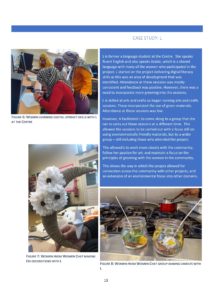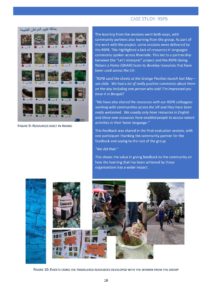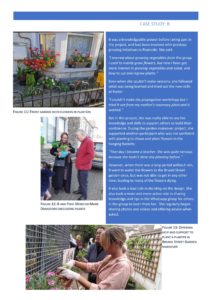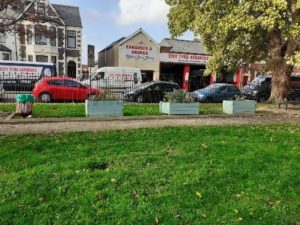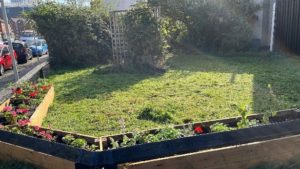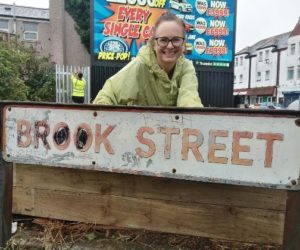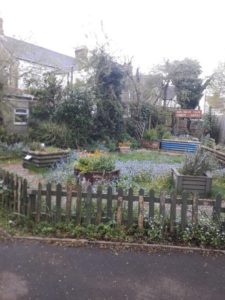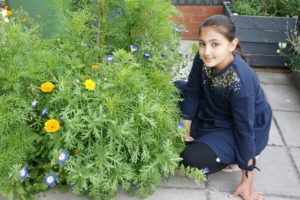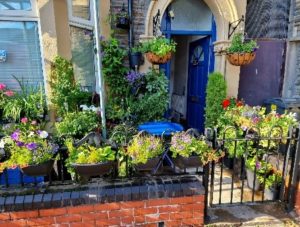A Local Plan for Nature in Riverside
South Riverside, Cardiff
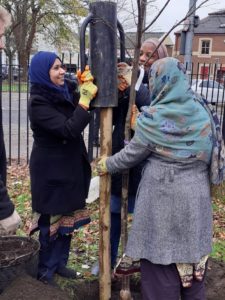
Planting Trees with Coed Caerdydd, Despenser Gardens
Date: March 2023
This report has been prepared for:
Louise Gray, Greening Riverside Project
South Riverside Community Development Centre (SRCDC)
Brunel Street, Riverside, Cardiff CF11 6ES
By:
Jen Loyd-Pain and Louise Gray in collaboration with the Local Plan for Nature in Riverside Steering Group and the South Riverside community
Table of Contents
- Introduction………………………………………………………………………………………………….
- The plan for nature and people………………………………………………………………………
- Making it happen: people tell the story……………………………………………………………
- The projects: in progress and ongoing …………………………………………………………….
- Partnerships and stakeholders………………………………………………………………………..
- Accomplishments………………………………………………………………………………………….
- Going forward: How do we do it?……………………………………………………………………
- Conclusion……………………………………………………………………………………………………
Figure 1: South Riverside Community Parks & Gardens and Greenspaces Surveyed
Appendices: Maps of South Riverside: Green Spaces (showing how little we have!);
Riverside Health Centre, S Morgan Place, Warehouse and Wyndham St
Kitchener Gardens and Primary School
Despenser and Clare Gardens
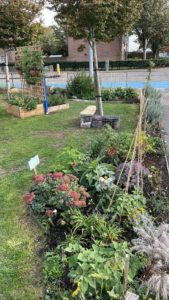
Grow Well Garden at Riverside Health Centre
- Introduction
The linked biodiversity and climate crises are having a significant impact on our ecosystems. Climate change is driving nature’s decline and the loss of wild spaces is leaving us ill-equipped to adapt to change (The Wildlife Trusts, 2023).
However, there is much that we can do to make a difference. A Local Nature Action Plan (LNAP) provides a foundation on which communities can build to declare what they will do to help nature’s recovery (South Gloucestershire Council, 2016).
Development of the Local Plan for Nature (LPN) in Riverside is the culmination of the 3.5 years of Greening Riverside Project funded by Welsh Government’s Landfill Tax Disposal then Breaking Barrier- Local Places for Nature. Managed by the South Riverside Community Development Centre (SRCDC), the goal has been to support local people in improving biodiversity, develop growing skills and to build a long-term sustainable ecological plan for South Riverside.
This plan for taking nature recovery forward is the result of considerable commitment from passionate members of the community, numerous partners and networks, and the organisers who have brought them together to get things done. All feel strongly about the role of urban neighbourhood ‘wild’ places in improving biodiversity, as well as the value of connecting people with nature for the benefit of residents.
The purpose of the LPN is to offer a basic framework. Guided by the LPN in Riverside Steering Group, an evolving project that included consultation with residents every step of the way to gauge priorities, map local greenspaces, engage volunteers, build collaborative relationships and foster co-existence. It is about creating habitats for wildlife and places for people that we can be proud of. Ideally these spaces will help plants and animals to thrive, thus allowing South Riverside to make its contribution to fostering biodiversity and mitigating the impacts of climate change.
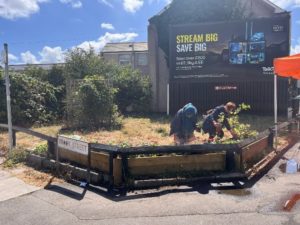
New planter at Brook St Community Garden
Objectives include:
- Connecting people with their local greenspaces through engagement and volunteering
- Building stronger relationships within the community
- Contributing to increasing biodiversity by restoring and creating habitats for plants, animals and people
- Learning growing skills, growing food for humans and pollinators
- Encouraging a greater awareness of how we can all work together to mitigate the impacts of climate change
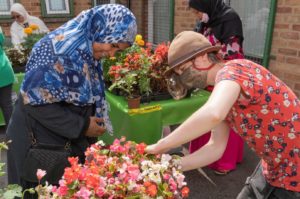
Learning together outside during Covid.
- The plan for nature and people
2.1 The environment
South Riverside is one of the most economically deprived areas in Wales with average mortality a full 12 years younger than the richest areas in Cardiff and the Vale of Glamorgan. For over a hundred years, Cardiff has been home to a significant population of people from South Asia, the Middle East and Europe. The area consists of communities from, India, Pakistan and Bangladesh, migrated in early 1960 and 1970 to fill the gap in labour market. The families of these individual has started to join. There were another group of communities starting to arrive from Middle East and Arabs, which include communities from Sudan, Libya, Iraq and Kurdistan. There are also communities from Europe, which consist of families and individuals from Italy, Poland and Czech Republic. Most of the change in the demographic of population is driven by patterns of migration, asylum seekers and student movements.
Spaces for nature include public parks and other greenspaces such as ‘scrap’ land, community and private gardens (see Figure 1), as well as every plant pot and crack in the pavement. The importance of containers and growing for pollinators in individual pots cannot be underestimated in terms of providing habitat connectivity and lifting the spirits of everyone. Every bee, butterfly and bird that visits makes a difference for biodiversity!
Figure 1 South Riverside Community Parks & Gardens and Greenspaces Surveyed
Clare Gardens
Despenser Gardens
Brook Street Community Garden
Riverside Warehouse Play Park
Wyndham Street Diner raised beds and borders
South Morgan Place Community Garden
Kitchener Gardens & Primary School
SRCDC Brunel Street back garden
Many street planters
Engagement activities and surveys
Engaging with the community is integral to nature recovery. Over the past three years, with the guidance the project leader and conservation professionals, volunteers have learned more about local plants and animals and taken an active role in helping to survey mapped habitats. This has paved the way for continued participation in resident directed activities, monitoring wildlife and the creation of additional habitat.
The Greening Riverside Project has engaged with over 700 households, facilitating over 20 growing events. Nearly 100 people now regularly contribute to a lively WhatsApp Growing group, where members share tips on how to grow food in a way that encourages biodiversity. The Tabiaa (Arabic for nature) Group is particularly focused on sharing wildlife observations, asking questions and learning to survey. These experiences are shared both on WhatsApp and in person.
During lockdowns and since the COVID 19 pandemic, South Riverside residents have expressed how important it is to be able to access a small amount of nature, even if it’s only in tiny front or back gardens. They have made the clear connection between the natural world and their wellbeing. The Greening Riverside project and the development of the Local Plan for Nature therefore complements the NHS Green Social Prescribing initiative, linking people to nature-based interventions and activities such as local walking for health schemes, community gardening and food-growing projects (NHS, 2023).
Educators delivered, and continue to deliver, a series of training sessions that provide an introduction to how to look after the local wildlife and green spaces.
Examples include:
- Meet the wild mammals of South Riverside – hands-on activities to give an overview of the wild mammals most likely present in South Riverside and their ecology with video, discussions and lots of sharing by volunteers
- Survey method instruction, including footprint tunnel surveys (Thomas and Wilson, 2016) and camera trapping in May 2022
- Pollinator habitat walk in Bute Park and follow-up learning – April 2022.
- Pond workshop May 2022 at Brunel Street Back Garden
- Wildlife Gardening in Brook Street Community Garden
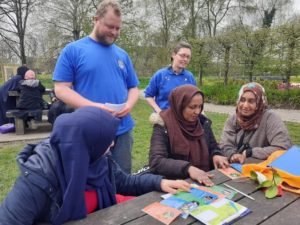
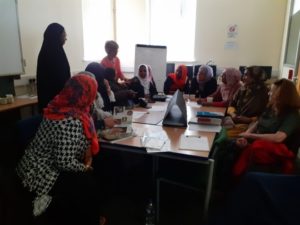
Outdoor learning — Habitats in Bute Park Indoor learning – What mammals are here?
Surveys, including visual observations, small mammal footprint tunnels and bird counts are ongoing.
With the help South East Wales Biodiversity Records Centre (SEWBREC) http://www.sewbrec.org.uk/ we have added to the list of recorded species.
Mapping of greenspaces – stepping stones and corridors
A baseline survey of South Riverside’s greenspaces was carried out in January 2022. It consisted of visual observation of wildlife and signs, habitat potential and the identification of natural environment features.
Prior to the survey a preliminary desk study involved searching historical records for the presence of plants and animals recorded within 1km of the SRCDC. According to National Biodiversity Network (NBN) Atlas, South Riverside’s greenspaces are important for the following:
- Plants – 196
- Birds – 83
- Amphibians – 2
- Insects – 58
- Mammals – 10
(NBN 2022)
Animals such as common and/or soprano pipistrelle bat Pipistrellus sp. were recorded, for which suitable dwellings and the established trees in Dispenser and Kitchener Gardens may provide excellent roosting and foraging habitat.
The best way to learn about nature in the neighbourhood and determining places for proposed habitat projects was to speak with local residents and volunteers along the survey route. For example, a volunteer working at the South Morgan Place Community Gardens pointed out where a hedgehog Erinaceus europaeus had recently been observed foraging in an adjacent hedgerow and front garden.
Although green space is limited and fragmented due to busy roads, there is considerable potential for nature. Habitat creation in South Riverside’s parks, as well as stepping stones and corridors for wildlife that connect these spaces, are important for increasing urban biodiversity. Ecological stepping stones are a series of small habitat areas that can act as corridors for the movement of species, even though they may be separated by relatively small gaps. In cities they are vital for connectivity (Luo et al. 2021). Roadside and private garden plantings for pollinators, trees and hedgerows (with access for animals to move through of course) are examples of stepping stones and corridors that create ‘highways’ for wildlife to move about safely.
Maps were created to visually illustrate the goal of improving habitats and connectivity, fostering biodiversity and increasing resident well-being. They were shared at the community launch of the project with Mark Drakeford, First Minister of Wales, to garner his support, as well as many photos and the stories from the people who helping to make this initiative a reality. For the following maps, please see Appendix 2.
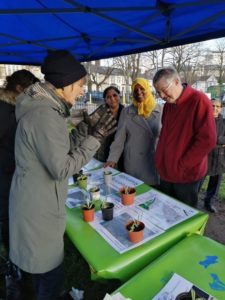
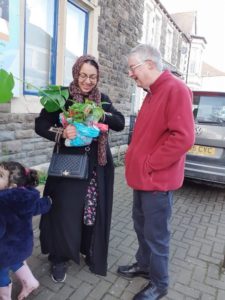
- South Riverside Community – Creating Habitats and Corridors for Wildlife:
Turning the map green for nature!
- South Morgan Place Community Gardens, Riverside Warehouse Park and Wyndham Street Day Centre: Proposed Volunteer Habitat Projects
- Kitchener Gardens & Primary School: Proposed Volunteer Habitat Projects
- Despenser & Clare Gardens and Clear Channel Greenspace (Lower Cathedral Billboard): Proposed Volunteer Habitat Projects
The first map depicts neighbourhood parks and greenspaces and additional features in overview. It shows the connectivity and fragmentation that currently exists, while excluding private gardens to show just how much they are needed as stepping stones, and what we already have. Additional maps zoom in on parks and greenspaces in different areas of the community, including suggested LPN volunteer projects prior to resident priorities being sampled.
2.2 The Community
The LPN aims to make wonderful spaces for nature and people in South Riverside that:
- Promote a sense of well-being
- Connect people with their spaces and encourage ‘ownership’
- Build cohesion among individuals, groups and organisations
- Keep both the needs of people and nature in mind – and combine them
With a view towards building a Local Plan for Nature, two face-to-face community meetings were held November 2023 and March 2023 to establish priorities for both nature and people in South Riverside. These were a few of the ideas most widely suggested for action that the Steering Group are taking forward:
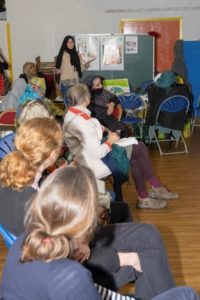
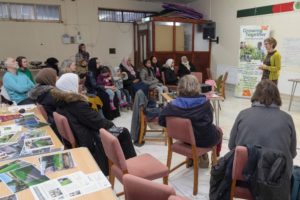
November 2022 March 2023 Final Community Meeting
- Improve seating in Despenser Gardens
- Provide seating around a central area of the Brook Street Community Garden
- The need for a second bin in Clare Gardens, particularly for recycling
- Connecting green spaces with a walking trail on the Love Exploring App
- A community friendly use for the hut in Despenser Gardens
- Further bulb planting around the logs, including wildflowers and no mow in Clare Gardens
- Blackberry picking in Brook St Community Garden
- An outdoor classroom at the back of Wyndham Street
- Low hedge planting around Despenser and Clare Gardens to help with air pollution
- Climbing flower and veg plants in the new planters at Riverside Warehouse Play Park
- Making it happen: people tell the stories
(Click to expand)
- The projects: in progress and ongoing
Clare Gardens:
- Creating a wildflower corner and introduce a hedgerow
- Installing a waste second bin
- Filling, decorating and fixing planters
- Possible installation of bird and bat boxes
- Proposal to hold a bat walk and possibly a bat survey
- Constructing a mini wildlife corner around the shed
Clare Gardens with new planters
Despenser Gardens:
- Making the space more accessible for girls and welcoming for all, attracting a balance of visitors and park users
- Consultation on sustainable use of the hut as a community friendly space that celebrates local cultures and promotes diversity
- Maintaining a variety of grass heights; shorter in certain areas for families to picnic and for safety and longer grass for wildlife with a path weaving through it
- Creating a seating corner or circular seating around a tree for socialising
- Erecting a disabled swing in the park and raising awareness of accessibility
- Possible installation of bird and bat boxes
- Planting bulbs and a wildflower area for pollinators
Brook Street Community Garden:
- Possible dog waste bin on the pavement
- New Gabion nature-friendly seating area
Riverside Warehouse Play Area:
- Craft session with a focus on growing presented
- Planting of new raised borders, including pollinator friendly plants
- Footprint tunnel surveys in May 2022
South Morgan Place Community Garden:
- Creation of a quiet space to sit and connect with nature and wildlife friendly planting already accomplished by volunteers. It’s close to where the hedgehog was spotted!
- Addition of daffodils to enhance beauty and resident wellbeing.
S Morgan Place – our secret community garden
Front Garden Planting Pockets
- Bees Knees project of ‘pulling paving stones’ to create residential pocket greenspace in residents’ front gardens. This is a partnership with the Probation Service Community Payback team based in South Riverside. A list of local residents have signed up to create a mini-wild flower meadow, like Ajwa’s in Machen Place.
Ajwar’s planting pocket in front Lisa’s front in summer
Other Riverside areas are currently monitored by the Park Ranger Team and have potential for future activities eg Kitchener Gardens.
[Photos]
- Partnerships and stakeholders
- Grow Cardiff
- Keep Riverside Tidy
- Women Connect First
- RSPB Cymru and Buglife
- Local Councillors
- Women Chat
- Cardiff Salad Garden
- Social Farms and Gardens
- Bute Nurseries
- Riverside Festival
- Food Cardiff
- Growing in Riverside, including many local individual growers
- Cardiff Bat Group
- Accomplishments
- Raised awareness of the value of local greenspaces for people and planet
- Highlighted the importance of nature recovery
- Fostered ‘ownership’ of the places we share with wildlife and one another
- Building stronger relationships among community organisations and individuals (language learning, women chat)
- Getting people more engaged with, and having greater input into, their community, including community meetings that empower people to put forward ideas, design projects/events in small groups and vote on them. The events and the greenspaces they promote belong to everyone in South Riverside.
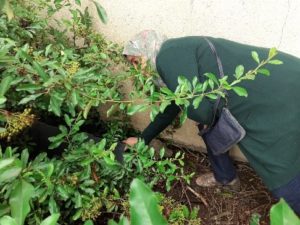
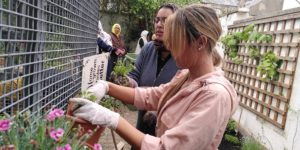
Laying foot print traps in the park Peer learning at Brunel St Back Garden
- Going forward: How do we do it?
As the LPN is a continuously growing and evolving blueprint, ongoing and new project ideas will be determined by further community and Steering Group meetings. Plans include:
- Love Exploring walking app to connect people with nature while getting fit
- Pedal Power – nature cycles are already up and actively running in nearby Bute Park [Photo]
- Increasing accessibility to Bute Park for South Riverside communities so that they feel safe
- Monthly sessions where people can make a difference for nature and each other-seed planting workshop in April, vegetable planting of new planters in May and themed park ranger engagement programming
- Greenspace surveillance – Volunteer surveys using methods such as observation, footprint tunnels and perhaps trail cameras
- Biological recording, perhaps even using iRecord to make a direct difference to conservation by contributing wildlife data to SEWBREC
- Events to connect people with the natural world and get our hands dirty such as bat evenings, bird counts, Bees Knees and, of course, continuing to plant for food and biodiversity
- Conclusion
The local plan for nature
The activities as part of this project and before this funding enabled the community to learn more
about the green spaces that they have access to and made them more accessible – giving people an
interest and ability to take an active part in planning for the future of these spaces.
The community meetings that took place as part of this project brought together a large number of
community members, including those who had been part of the project, others who had not, and
community partners and council members and staff. The level of engagement from the community
was high, facilitated by:
– Providing food at the events
– Providing childcare
– Having a flexible approach to the agenda
– Facilitating small groups for discussion
– Widely disseminating the details about the event on Whatsapp, social media, with leaflets
through doors and with posters.
However, from the discussions in the evaluation, this engagement was largely due to the trust that
community members had in the project lead and other members of the team. Without these people
in post, maintaining such a high level of engagement with the local community will likely be difficult.
The project lead took advantage of all opportunities possible to bring people together to work on
the local plan for nature, including working with Cardiff Council to develop an app to highlight green
spaces in Riverside. Again, without the project lead in place, getting the engagement needed to
facilitate the development of this with the local community will be difficult.
The community meetings led to a number of ideas and priorities for the local community. However,
some would need local council funding to be achievable.
In summary, the project lead was able to bring together a diverse range of stakeholders to input into
a local plan for nature. People felt able to contribute their ideas and were facilitated to express their
priorities. However, this level of engagement and consultation work is built on years of building
trusting relationships in the community and with partners. This resource – the project lead with her
knowledge, commitment and connections – will be lost to the community at the end of the project
and may not be replaceable.
- References
Luo, Yuhang , Wu, Jiansheng ,Wang, Xiaoyu, Peng, Jian (2021) ‘Using stepping-stone theory to evaluate the maintenance of landscape connectivity under China’s ecological control line policy’, Journal of Cleaner Production, 296(126356)
NBN Atlas (2022) [Online] [Accessed 11th January 2022]
https://records.nbnatlas.org/explore/your-area#51.4774189|-3.1907134|12|ALL_SPECIES
NHS (2023) Green Social Prescribing [Online] [Accessed 9th March 2023]
https://www.england.nhs.uk/personalisedcare/social-prescribing/green-social-prescribing/.
Ordnance Survey (2022) Open Street Map and Google Satellite
[Accessed via QGIS QuickMapServices and online at OS OpenData Downloads, February 2022].https://osdatahub.os.uk/downloads/open
South Gloucestershire Council (2016) Local Nature Action Plans: guidance for town and parish councils
Thomas, E. and Wilson, E. (2018) Guidance for surveying hedgehogs, British Hedgehog Preservation Society, Peoples Trust for Endangered Species & the British Hedgehog Preservation Society [Online] [Accessed 27 March 2022]
https://ptes.org/wp-content/uploads/2018/05/Guidance-for-surveying-hedgehogs-2018.pdf.
The Wildlife Trusts (2023) Things you can do about climate change [Online] [Accessed 7th March 2023]

